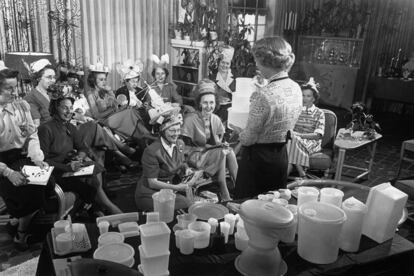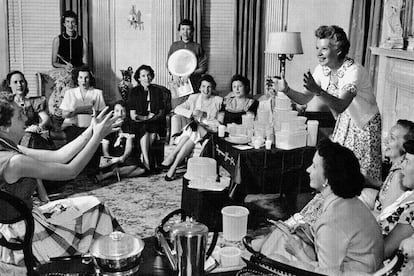The end of Tupperware: Why the empire hasn’t survived the 21st century
After more than 75 years of popularity, the multinational is on the brink of bankruptcy

Taking into account Hollywood’s uninhibited passion for products that are part of pop culture, it’s surprising that the film mecca’s great minds have yet to draw inspiration from Tupperware. One may believe that the vacuum-sealed containers used to store food aren’t as attractive to audiences as Air Jordans, Tetris, Blackberrys or Hot Cheetos, to mention just a few of the products whose spinoffs have reached theaters this year. But the story of the mythical Tupperware company brings together the ingredients of all great films: ambition, delusions of grandeur, unexpected heroines and global success. The script may have a tragic ending, though: the company’s future is in danger.
After more than 75 years, the company today finds itself at the brink of bankruptcy, due to its plummeting sales and high debts. Not even a revaluing of its stocks last August, fed by jokester investors attempting to repeat the Gamestop incident, has been able to stop its decline. Its leaders have made public their concerns about their “capacity to go on.” Many reasons can explain its decay: changes in consumption trends, a shift to materials more sustainable than plastic, its aging brand image, an erratic digital transition, a lack of innovation and an ever-more-diverse array of competing products.
But one of the most concerning aspects for the company, according to retail expert Andrew Busby as quoted in The Telegraph, is the collapse of the direct-sale model since the COVID-19 pandemic. Since the 1950s, Tupperware has made most of its sales in home gatherings hosted by independent sellers. The company allows ambassadors to gather together a group of friends and families, choose the party’s theme and the recipes that a consultant will cook to show off their products’ uses. The multilevel sales model is similar to that of cosmetics brands like Avon and Mary Kay, which have also seen interest dwindling with Generation Z.
The brand is named after its founder Earl Tupper. Born in 1907 to a family of farmers in Massachusetts, he showed an entrepreneurial spirit from an early age, selling the harvest from door to door at just 10 years old. He thought of himself as a sort of modern Leonardo Da Vinci. After finishing high school, he tried to sell some of his inventions, like a dagger-shaped comb worn as a belt attachment and personalized cigarettes. After marrying Marie Whitcomb, he opened a gardening and landscaping business that closed during the Great Depression, and he went on to work as an operator in a plastic factory. But the bumps in the road didn’t affect his ambition, and after a year working there, he bought molding machines and began to make containers for cigarettes and soap. With the introduction of polyethylene as a material, and the sale of sealed containers like paint tins, Tupper Plastics found its place in kitchens across the United States. Within just a few years, 76% of the country’s homes had at least one of the brand’s products. The Wonder Bowl was one of the company’s first star products thanks to its lightness and resistance. It is rumored that Queen Elizabeth ate her cereal out of it.

But the true mind behind Tupperware’s popularity isn’t Earl Tupper, but the company’s first host, Brownie Wise. Born in a rural Georgia town, this marketing visionary was a working single mom with elementary-level education who lived with her mother and sold brooms to maintain her family. When Wise discovered Tupper’s products, she decided she wasn’t going to become just another door-to-door seller. She organized her own parties with gifts and games to demonstrate the working of the novel product, socialize among neighbors and debunk the myths behind consumers’ resistance to plastic. Wise recruited other women who repeated her strategy all across the country and sold dozens of containers each week. One of her recommended games consisted of playing catch with a container full of juice.
Wise became the public face of Tupperware, appearing in specialized publications and women’s magazines. In 1951, Tupper named her Vice President of marketing, a landmark event at a time when women were practically banned from executive roles. According to PBS, “Brownie Wise and Earl Tupper were an odd, but perfect, match. She was flamboyant and extroverted; he was reclusive and secretive. She was good with people; he was good with machines. He knew how to produce things, and she knew how to sell them.” Their influence was such that Oscar winner Elizabeth Taylor once hosted a Tupperware party on her yacht.

But the founder, increasingly outshone by Wise, couldn’t contain his jealousy. In 1958, he fired his Vice President. Soon afterwards he sold the business. He took home $16 million, while Wise’s severance pay was just $30,000. Earl Tupper divorced his wife and went to live in Costa Rica. He gave up his United States citizenship to avoid taxes and dedicated his time to his inventions. Alison Clarke, author of the book Tupperware: The Promise of Plastic in 1950s America, has recovered some of their legacy: “One reason for the extraordinary success of Wise’s approach is how alienated suburban women were at the time. Tupperware parties offered a justifiable domestic reason to get together with other women.”

Sign up for our weekly newsletter to get more English-language news coverage from EL PAÍS USA Edition









































